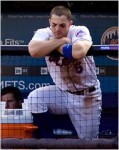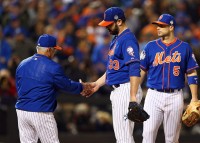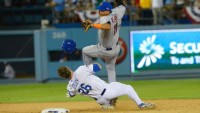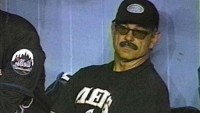
When David Wright came up in 2004, we thought every year was going to be like last year. Much like this year, we anticipated that each and every year Wright manned third base, the Mets would contend for a World Series.
As we know, it didn’t happen that way. A lot went wrong. The Mets came ever so close in 2006. They collapsed in 2007 and 2008. A poorly designed outfield, poor personnel decisions, and financial crisis ensued. Then, as things began to turn around, Wright injured his hamstring. Then he was diagnosed with spinal stenosis. Last year was his first trip to the World Series. This year may be his last year as a key contributor on a World Series team.
It could also be Wright’s last year to build his Hall of Fame credentials.
Third base is the least represented position in the Hall of Fame. Accordingly, standards are high to enter the Hall of Fame as a third baseman. The average of 13 Hall of Famers at the position had a career WAR of 67.5, a WAR7 (best seven years combined) of 42.7, and a JAWS of 55.1. Looking at the stats, Wright falls short. His career WAR is 50.1. His WAR7 is 40.0. His JAWS is 45.1. For a player that Mets fans believed would be a Hall of Famer, he now has an uphill climb.
WAR7
Looking at theses factors, it’s presumably easiest for Wright to increase his WAR7. To do so, he would need to have one year where he accumulates 2.7 more WAR that his seventh best season. Here are his seven best WAR seasons:
- 2007 – 8.3
- 2012 – 7.0
- 2008 – 6.8
- 2013 – 5.9
- 2005 – 4.8
- 2006 – 4.1
- 2009 – 3.2
For Wright to put his WAR7 within range, he would need to have one more season that is 5.9 or better. Wright last did that in 2013. That year Wright only played on 112 games. He hit .307/.390/.514 with 18 homers and 58 RBI. His 156 OPS+ was the best of his career. In that season, Wright missed a significant amount of time with a strained hamstring. Sounds just like his April 2015 hamstring injury that wouldn’t heal.
The Mets are hopeful that Wright can play 130 games in 2016. Judging from Wright’s 2013 season, it is certainly possible that Wright can have a 5.9 season again. A better and much stronger Mets lineup will assist him in that task.
Cumulative WAR
Going into the 2016 season, Wright has a career WAR of 55.1, which is presumably 12.4 behind the 67.5 career WAR he would need to be enshrined in the Hall of Fame.
This is where things may get a little tricky for Wright’s chances. Don Mattingly had back problems, and his once promising Hall of Fame career was over at 34. Lenny Dykstra had spinal stenosis, and his career was over at 33. David Wright is entering his age 33 season. Based on other player’s careers, he’s near the end of his career. If Wright plays past his age 34 season, he will be in uncharted territory.
Naturally, it is safe to assume Wright will not have a 12.4 WAR season thereby cementing his Hall of Fame case. To do that, Wright would have to match Babe Ruth‘s 1927 season when he hit 60 homeruns. No, if Wright is going to accumulate the needed 12.4 WAR, he’s going to have to remain healthy and effective. He’s going to have to manage his spinal stenosis.
Wright is currently signed until 2020. There are $90 million reasons why Wright will do all he can to finish that contract.
Presuming Wright does do that, he has five more years left in his career. In order to attain the necessary 12.4 additional WAR, Wright will have to average a 2.5 WAR a year for those five seasons.
In 2014, Wright played 134 games, and he was a 2.7 WAR player. In that season, he hit .269/.324/.374 with eight homers and 63 RBI. If Wright manages his back, and his treatments are effective, seasons like this over the next five years are certainly attainable.
Other Criteria
As Wright’s peak is over, there really isn’t anything he can do to improve his JAWS. With that in mind, we need to look at other areas that would improve Wright’s Hall of Fame case.
Unfortunately, he will be unable to surpass Mike Schmidt‘s 548 homeruns or even reach the once magic number 500 homeruns. He won’t catch Chipper Jones‘ 1,623 RBI. He won’t catch Brooks Robinson‘s 16 Gold Gloves at third base. It does not appear Wright will reach 3,000 hits as he would need to average 250 hits over the next five years to reach that number. No, it seems like the only thing that will help Wright is the narrative.
The best thing going for Wright is the fact that he will most likely play his entire career as a Met. Aside from Tom Seaver, Wright is making a case as the best player to ever play for the Mets. Here are his Mets rankings:
- Games Played – Second (307 behind Ed Kranepool)
- Runs – First
- Hits – First
- Doubles – First
- Homeruns – Second (17 behind Darryl Strawberry)
- RBI – First
In addition, Wright’s 50.1 WAR with the Mets is the second most any player has accumulated with the Mets; the most accumulated by any Mets position player. Even with Mike Piazza‘s recent election to the Hall of Fame, it appears that Wright is the team’s best position player.
So overall, Wright still has a legitimate shot at the Hall of Fame. His name will be atop all the major offensive catergories. His WAR and other catergories will put him on the cusp of election. A strong 2016 will get him a lot closer to those goals.
Winning a World Series in 2016 can’t hurt either.
Editor’s Note: this article also appeared on metsmerizedonline.com

Today, the Mets officially report to Spring Training. With the 2016 season unofficially starting, David Wright begins his most important year as Captain of the New York Mets.
Back in 2007, Wright was a 24 year old superstar. His team was coming off a shocking loss in the NLCS, and yet going into 2007, many believed the Mets were the best team in the National League, if not all of baseball. With Wright and Jose Reyes, the Mets were seen not only as a win-now team, but also as a team that was built for the long haul. It worked out that way for exactly 145 games.
Not that Tom Glavine finds it devastating or anything, but the Mets collapsed over the final 17 games. There are a number of things we can point to as the reason the Mets collapses. Over those final 17 games, Brian Lawrence, a 23 year old Mike Pelfrey, and Philip Humber received starts with the Mets going 1-3 in those games. You can point to players like Reyes not hitting down the stretch. Speaking of Reyes, many point to him dancing in Game 161 as the reason.
After the Mets were swept by the Phillies, they had 14 games remaining against sub .500 teams. These teams had a combined .457 winning percentage. This includes a Cardinals team that had to come to New York to play a make-up game. They shut the Mets out. After the Phillies swept the Mets, there was every reason to believe the Mets would win the division, or at the absolute worst, the Wild Card. They did neither. There really is no excuse for what happened.
We saw it again in 2008. The Mets had a lead in the division up until the 149th game of the season. The Mets then lost the division lead. Again, the Mets season was on the line on the final game of the season. Again, they lost at home to a bad Marlins team.
Sure you can point to a myriad of things in 2008. Billy Wagner was injured leading to a revolving door at closer. Again, it’s excuses. The Mets had a different manager and pitching coach at the end of the season. Willie Randolph and Rick Peterson were the fall guys for 2007 in getting fired one game into a West Coast trip.
At the end of the day, it wasn’t the manager or the coaches. It was the team. There just was something missing. One player that wasn’t a problem? David Wright.
In 2007, Wright hit .352/.432/.602 with six homers and 20 RBI over the final month of the season. In 2008, Wright hit .340/.416/.577 with six homers and 21 RBI in the final month of the season. While Shea was burning, Wright was playing his best baseball. While there was a problem with those 2007-2008 teams, Wright wasn’t one of them.
Now, Wright is the only player that remains from those teams.
Wright is now 33 years old. He’s a leader on the team. He’s the Captain. Once again, he’s on a Mets team that has a chance to return to the postseason. He’s once again playing for a team that is a legitimate World Series contender.
This may be Wright’s most important season as the Captain. He can share with the team all the things that went wrong in 2007 and 2008 to help prevent any of these issues arising with this Mets team. If problems do arise, he can help guide the team. He can share with them whatever it was within him in 2007 and 2008 to play his best when the team seemed to be at their worst.
In 1986, the Mets had a de facto team captain in Keith Hernandez that showed the team how to win. Thirty years later, the Mets have a Captain that can show the team how not to lose.
Hopefully, with another Mets captain leading the way, the Mets will once again win the World Series.

One of the many topics of this offseason has been about how all the Mets players love the team and how they want to stay here. Jacob deGrom said he would sign an extension. Now, it’s Matt Harvey‘s turn:
Matt Harvey said extension talk has never come up with the #Mets, but he hasn't "shied away" from it.
— Adam Rubin (@AdamRubinMedia) February 15, 2016
No, it’s not exactly a ringing endorsement. However, to me it’s a clear sign that he really is willing to sign an extension. Following Harvey’s career, there is no reason to believe otherwise.
Long before Harvey was drafted and became a part of the Mets organization, he was drafted by the Angels right out of high school. His association with Scott Boras raised questions about his signability. It caused him to slip to the third round. He informed the Angeld he would not sign unless he had a $2 million signing bonus. He would not accept $1.99 million. Accordingly, he would not accept the $1 million the Angels ultimately offered. Harvey rejected it despite his father telling him to take it, and he enrolled at the University of North Carolina.
Reading this, you may be led to believe that Harvey is just doing whatever Boras tells him to do. That premise should’ve been disproven after last year.
In 2012, Stephen Strasburg returned from Tommy John surgery, and he was famously shut down prior to the postseason. That decision was made when Scott Boras and GM Mike Rizzo agreed to Strasburg’s inning limits. Once Strasburg hit those limits, he was shut down. Boras tried to similarly intervene with Harvey.
As the timeline shows, Boras tried to get the Mets to limit Harvey to 180 innings. The main hurdle to that was it wasn’t what Harvey wanted to do. Instead of working with Sandy Alderson and Scott Boras, Harvey talked with his manager. It was Harvey and Terry Collins together that decided what Harvey needed to do. Harvey pitched more in September than the Mets, or Boras for that matter, thought he would pitch.
For better or worse, Harvey has always been in charge of his own career. It seems that on the field, he wants to compete at the highest level. For these actions, Harvey wants to be paid what he thinks he’s worth and not one penny less. That’s why Boras is his agent. He hired the guy who has a reputation of getting teams to pony up top dollar for the players he represents.
As noted by Adam Rubin today in his Morning Briefing, the belief that Boras’ clients don’t sign extensions prior to their hitting free agency is not entirely true. As Rubin notes, twenty-four of Boras’ clients have signed extensions with their teams before reaching free agency. Ironically, one of them was Jered Weaver, who signed an extension with the Angels; the same Angels who couldn’t find an extra million to sign Harvey.
So yes, it’s entirely possible the Mets can sign Harvey to an extension prior to his hitting free agency. Prior to this offseason, I would’ve been extremely pessimistic about the possibilities. However, this offseason the Mets re-signed Yoenis Cespedes thereby proving anything is possible.
I don’t know the Mets chances of re-signing Harvey. The only thing I do know is that Harvey is not going to accept one penny less than what he thinks he’s worth no matter what his family or his agent says.

Next year, Chase Utley is going to be a utility player. He going to be a utility player because he’s 37 years old, and he has diminishing skills. He could retire, but he decided to hang around for another year or two. He’s not in this situation because someone injured him.
Last year, Ruben Tejada was not the starting shortstop on the Opening Day roster for the first time in his career. No, last year, the job was given to Wilmer Flores. Tejada was going to be a utility player to start the season. Then something strange happened. For all the years of the Mets just handing him the job, and him failing to hold onto it, Tejada finally rose to the challenge the year the job wasn’t just handed to him.
Last year, Flores had his offensive and defensive struggles. The Mets team was decimated by injuries. Tejada got some regular playing time. He then got some time at shortstop. He showed that while he had less range than Tejada, he had a steadier hand. More importantly, he began to hit:
- July .287/.330/.347
- August .235/.381/.294
- September .297/.357/.406
He entered the postseason as the Mets starting shortstop over Flores. He earned that right. Then with one dirty play Chase Utley took it all away. Tejada broke his leg. In the offseason, while he was hobbling around with a walking boot, the Mets signed Asdrubal Cabrera to take his place.
Utley reportedly reached out to David Wright to apologize to Tejada. He reportedly sent Tejada some things in the offseason. For his part, Tejada says all he wants is an apology.
Up until now, Utley has gone on and on about how he was playing hard and that he was playing the right way. However, his actions at least show remorse. The reason for this is he broke an unwritten rule, perhaps the most important rule amongst all players in all sports. You don’t injure other players with dirty, or even borderline plays. You don’t ruin another player’s career. Utley did that.
Utley took away Tejada’s job with one dirty play. Like Utley, Tejada is now a utility player. For what it’s worth, Tejada is not letting this hold him back:
I’m going to keep working hard, you never know what’s going to happen here. I want to stay focused all the time.
In 2015, Tejada was a utility player to start the season, and he finished the year as the starting shortstop. Utley put him back in that position this year. I’m not counting out Tejada this year, especially with dirty players like Utley out there.

The general consensus as to why Hall of Famer Walter Johnson was so dominant was the saying, “You can’t hit what you can’t see.” In analyzing MLB’s Statcast data, that saying could now be applied to the young New York Mets pitching staff.
As the article notes, the Mets threw more pitches than any other team over 95 MPH. Nearly a thousand more. The main reason for this was the trio of Matt Harvey, Jacob deGrom, and Noah Syndergaard. Harvey’s two-seamer averaged 95.4, and his four seamer averaged 95.3. deGrom’s two seamer averaged 95.6, and his four seamer averaged 96.0. As all Mets fans know, Syndergaard led the pack. His two seamer averaged 98.3, and his four seamer averaged 98.4. Amongst starting pitchers Symdergaard threw the fastest.
This trio of hard throwing righties kept the Mets afloat in 2015 while the offense spluttered. When the team then assembled a major league capable offense, these pitchers led the Mets to the World Series. In 2016, it’s only going to get better.
Last year, the Mets had innings limits, skipped starts, and at times, six man rotations. Syndergaard wasn’t called up until May. In 2016, the Mets have said innings limits and the like will not be an issue. As such, all three of the Mets aces should be expected to make 32 starts and throw over 200 innings. This means more 95+ MPH fastballs. Again, batters will have trouble hitting the pitches they can’t see.
If that wasn’t enough, it gets even better. Steven Matz should start the year in the rotation. According to Brooks Baseball, Matz’s fastball averaged 94.57 MPH. Prior to Matz’s lat injury, his fastball averaged 94.90 MPH. With a full season of a healthy Matz, the Mets will further increase the amount of fastballs throw over 95 MPH.
In addition to a full season of Matz, the Mets can expect a half a season of Zack Wheeler. In Wheeler’s career, his four seamer averaged 95.87 MPH, and his sinker averaged 95.50 MPH. All told, upon Wheeler’s return, the Mets will feature a starting rotation that has five pitchers bringing the heat at over 95 MPH. That is just incredible.
However, why does it matter? Well, as FiveThirtyEight showed last year, it is just harder to hit a fastball that’s thrown 95 MPH and above. In total, batters swung and missed at pitches thrown this fast 22.8% of the time. That’s about 5-10% more frequent than pitches thrown slower.
More importantly, as we saw in last year’s NLCS, the Cubs are more likely to swing and miss at these pitches than any other team in baseball. Heading into the 2016 season, it appears that yet again it will be the Cubs standing in the Mets way. The pitching staff the Mets have constructed is not only effective against the Cubs, but also every single team in baseball.
The Mets 2016 pitching staff is the single best argument why any team in baseball will go to and win the World Series. The Mets young starters brought the heat last year. Next year will be more of the same.
Good luck to the National League next year because you can’t hit what you can’t see.
Editor’s Note: this article first appeared on metsmerizedonline.com

Major League Baseball and the Players’ Association should be commended for creating the best steroid testing policy and penalty system in all of professional sports. With the Collective Bargaining Agreement expiring after this season, it’s time to reevaluate the steroid policy and make some changes.
After seeing the saga of Jenrry Mejia, I believe there is some room for improvement.
The first issue is that Mejia came back at all in 2015. While Mejia was serving his first suspension, he again tested positive. Mejia got to pitch in seven games before the second suspension was finally levied. At this time, the Mets and Nationals were separated by two games and were about to head into the All Star break. Mejia had an impact on a pennant race even though he tested positive for steroids. Overall, there was no reason why he should’ve played.
Baseball should implement a rule that a player cannot return from a steroid suspension unless they pass a steroid test.
Now, in the case of Mejia, he never would’ve pitched in 2015. That would’ve been a good thing. It would’ve prevented a steroid user from having any impact upon a pennant race.
Keep in mind, this is a slight tweak of the current testing policy. Under the current policy, a player who tests positive is subjected to increased testing over the course of the year. However, it calls for increased random testing, not time specific testing. Rather than do completely random testing, there should be a blood and urine test right before the players is scheduled to return. When and only when the player passes that test, the player can then return.
The next issue to be addressed is what to do with these players if they test positive on their reinstatement test. Under the current policy, these players would receive an additional suspension. As we saw with Mejia, he pitched all of seven games in the 2015 season before his career was done.
Research seems to indicate that anabolic steroids, like the ones taken by Mejia, are addictive in nature. An abuser of anabolic steroids can experience depression, and worse, may become suicidal. Now, I can’t tell you Mejia is depressed or suicidal. What we can see however is that Mejia showed signs of addictive behavior. Mejia continued to use steroids even though it was to his detriment.
Now, if Mejia had been caught using cocaine or another “drug of abuse,” Mejia would’ve been placed in a treatment program. However, because Mejia used steroids instead of heroin, the treatment program was not an option, at least as the drug policy is currently written. It’s very well possible Mejia needed help, and it was not available to him.
Don’t misunderstand me. Mejia is a cheater. He deserved his first suspension. No one ever forced him to take Stanozol. However, if he truly became addicted to steroids, there should be measures in place the help Mejia rather than just throw him out of baseball. Therefore, the penalties for steroid use should be changed to address this issue.
For the first offense, a player should still be suspended for 80 games. However, I believe that should become a minimum suspension. If a player cannot pass the aforementioned reinstatement steroid test, the treatment program provisions of the “drugs of abuse” should come into effect. The 80 game suspension should then become an indefinite suspension. It should not trigger the 162 game penalty at that time.
Under this new plan, a player who tests positive the first time could effectively be suspended longer than 80 games, 162 games, or possibly more. It really is up to the player. If a player is addicted, and needs help, the avenues should be there for them. If the player continues to test positive, and refuses to accept treatment, the “drug of abuse” treatment providions should apply:
- First failure to comply: 15-25 game suspension;
- Second failure to comply: 25-50 game suspension;
- Third failure to comply: 50-75 game suspension; and
- Fourth failure to comply: one year suspension and whatever additional penalties the Commissioner sees fit.
Essentially, the goal should be to get the addicted players the help they need. If they fail to comply, the refusal to seek treatment penalties should apply instead of the 162 game penalty. Once the player has completed their program and can pass a reinstatement test, they should then be allowed to return to baseball.
If, after all of that, a player tests positive a second time, that player should receive the 162 game suspension. After a second suspension, the player should automatically be enrolled in a treatment program. After the 162 game suspension, the player should again be subjected to a reinstatement test. Additionally, that player should not be reinstated until they pass that test.
If a player fails a third test after all of this, that player should then receive the lifetime suspension.
Right now, there is a 26 year old reliever who may have a substance abuse issue. It was his fault for starting in the first place. With that said, baseball failed to put steps in place that could have helped him. The second and third suspensions might have been prevented. If he used cocaine like Josh Hamilton, he would still be in baseball.
Mejia cheated and deserved his suspension. After that, he was penalized because he was addicted to steroids instead of cocaine. It’s time baseball got steroid users the help they may need.

It’s that time of the year when we get that warm and fuzzy feeling. It’s a time when you feel even closer to what you love. I am of course referring to Pitchers and Catchers reporting to Spring Training this week.
As the Mets report, they are trying to do something that only Bobby Valentine’s Mets have ever done. They are trying to go to the postseason for consecutive years. It’s still amazing to think that in the 54 year history of the Mets, they have only e been in consecutive postseasons only once. Gil Hodges couldn’t do it. Davey Johnson couldn’t. Willie Randolph came agonizingly close.
No, the only one to do it was Bobby V. He did it with a core of Mike Piazza, Edgardo Alfonzo, Robin Ventura, and Al Leiter. He had a terrific bullpen of Armando Benitez, John Franco, Turk Wendell, and Dennis Cook. Each year, he had drastically different outfields and rotations. Yet, he was still able to make it work. He got the most out of these teams. The Mets made consecutive NLCS appearances, and they were close to winning a World Series.
This now is the task set forth for Terry Collins. For the first time in 16 years and the second time in Mets history, he is tasked with leading a Mets team to consecutive postseason berths. Like Bobby V, he has a strong core of players. Unlike Bobby V, he has not had much turnover in the roster.
Overall, the one thing uniting Bobby V’s Mets and Terry Collins’ Mets is hope. Mets fans hope and believe in this team. We all believe this is our year even after a heartbreaking loss. And yes, as this is Valentine’s Day, Mets fans love their team.
So remember on this the coldest of Bobby Valentine’s Day, Spring is in the air, and we will soon be reunited with the team we love.

Tomorrow is Valentine’s Day. If you haven’t gotten your wife, fiancée, or girlfriend something, you have less than 24 hours to get something. Good luck on such short time constraints.
Now, if you didn’t send the woman in your life something yesterday, you still have time to do something special. At least from my experience, my wife loves getting flowers at work. It’s a bigger deal around Valentine’s Day because there is usually a parade of flowers coming into the office. You don’t want your significant other to be the person that received nothing:
Luckily, with Valentine’s Day being on a Sunday, you have an out. You can have flowers sent on Monday and pretend it was the plan all along.
Now, I know the main issue with sending flowers this time of year. It’s incredibly expensive. It’s more expensive having them delivered. The price will go up when you consider you’re ordering them at the last minute. There’s a way to dramatically reduce the cost.
Go pick up the flowers yourself. You can get them from a florist or a grocery store. By picking them out yourself, you have the added benefit of making sure the flowers are in good shape. Trust me, these places will send out whatever they have in stock. The only thing worse than sending nothing is sending out garbage. Sending nothing means you forgot. Sending awful flowers embarrasses her. This prevents that.
Once you have the flowers,drive to your significant other’s job and drop it off at the front desk or security. They will deliver the flowers to your significant other’s desk. Trust me. It will have the same effect as the flowers being delivered by a florist or 1-800 Flowers. Remember, the idea is not to spend a lot of money. The idea is to make her happy.
I hope this helps. Good luck and enjoy your Valentine’s Day.

Well unless you’re living under a rock, by now you’ve heard that Jenrry Mejia is permanently suspended from baseball for testing positive for steroids use a third time. The universal take is that he was incredibly stupid. At first, that was my take as well.
However, there is something in me that began to question this premise. The one question I kept coming back to was why would he continue to use steroids while he was on suspension? There was nothing he could gain from it. He wasn’t eligible to pitch until the 101st game of the 2016 season. It just doesn’t make sense for him to get busted for using steroids half a year before he was even allowed to pitch.
To gather an understanding of what happened, let’s first start with the banned substances Mejia was taking and the correlating suspensions:
- April 2015: Stanozol
- July 2015: Stanozol and Boldenone
- February 2016: Boldenone
Looking over this list, there are two things that jump right out at me. The first is he tested positive for a banned substance during a suspension. The next is that each time he tested positive, he tested positive for a banned substance he had tested positive for in an earlier test.
What is interesting about Stanozol is that with one injection, the presence of Stanozol in your system can be identified for several months. Therefore, it is at least possible that Mejia tested positive for Stanozol in April and July for just one injection. What’s problematic for Mejia is he also tested positive for Boldenone in July. As such, there were two banned substances present in his system.
Now, Boldenone can be detected in your system for a whopping 16 – 18 months after its been injected into your body. Again, it is possible that Mejia tested positive twice for one dose. Whether or not you choose to believe this is what happened is up to you. However, scientifically, it is plausible Mejia is getting suspended a second time for the first (and only?) Boldenone dose he took.
For his part, Mejia has stated, “It is not what they say. I am sure that I did not use anything.” He also states that, “I am going to appeal. Lose or win, I have great faith. I have to clear my name. I will take this case to the ultimate consequences.”
It should be noted that Mejia never appealed his first suspension despite claiming he had no idea how Stanzonol got in his system. There were no appeals or statements after the second suspension. It seems now with his baseball life on the line, he’s not going to go down without a fight.
Unfortunately for Mejia, he is unable to appeal this third suspension. If he is going to have if overturned, he will have to go the Tom Brady route and sue Major League Baseball. The question is whether or not he has a good case.
In judging that, we are at a disadvantage. It’s possible that Stanozol and Boldenone could remain detectable in a person’s system over a long period of time. What we don’t know is the levels detected in Mejia’s body. If these levels significantly decreased, it’s possible Mejia got nailed twice for the same dose. That’s inherently unfair. In that respect, remember Mejia twice tested positive for Stanozol in a three month span. However, Stanozol was not found in this latest test.
Stanozol itself is interesting here. This year there was an inordinate amount of Stanozol usage. As a result, Commissioner Rob Manfred determined that the issue needed to be investigated.
Looking over the Stanozol suspensions each player was from Latin America. Over the course of baseball’s steroid testing, players from Latin America have been suspended more than players from anywhere else. The Dominican Republic, where Mejia is from, has more steroid suspensions than any other country. It’s clearly an issue.
For what it’s worth, Latino Sports published an article examining Mejia’s second steroid suspension. In the article, it was alleged Mejia tested positive the first time because of an injection he received while he was having asthma problems. It was also alleged Mejia could’ve avoided the second suspension altogether by naming the individual who gave him the steroids. The article alleges this person was working with other baseball players as well. For his part, Mejia was quoted as saying he had no dealings with that person.
While I’m skeptical about this Latino Sports article, I will admit it fits the narrative of MLB conducting an investigation into the increase in Stanozol usage.
At this point, I don’t know what to believe anymore. On the one hand, I cannot fathom how anyone can continue to take a banned substance knowing if he did his career was over. It’s inane to take something again without first seeing if you could compete without it.
And yet, Mejia did test positive three times. All we have to try to make sense of everything is guesswork and rumors. It’s not exactly how you build a strong case.
While I can rack my brain to try to figure out how this possibly happened, I keep coming back to my initial reaction. Maybe Mejia is just that stupid.

